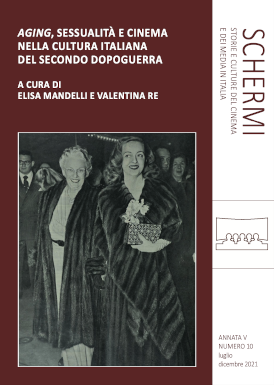«È l'arte che conta non l'età». "Aging", divismo e protagonismo femminile in "Siamo donne"
DOI:
https://doi.org/10.54103/2532-2486/15391Parole chiave:
Italian cinema, Italian women, Aging, Stardom, Acousmatic voiceAbstract
The film Siamo donne (We, the Women, 1953), written by Cesare Zavattini and divided into five episodes, represents an iconic case study to observe women of different ages and belonging to distinct generations. On the one hand, the first episode focuses on the ambitions of the young girls participating at the contest “Four stars and a starlet”; on the other hand, the following episodes, starring four celebrities playing the part of themselves, highlights the disillusions and regrets of mature women both in their private and professional life. Work, household, motherhood, and nostalgia are the main topics that interrelate with the portrayals of female aging provided by each episode. The film is a valuable opportunity to reflect upon the practices of cinema consumption and stardom in the 50s, especially from the contestants’ point of view. Throughout the analysis, we will also pay attention to voice over narration and the function of acousmatic voice as a memory device and expression of female subjectivity.
Dowloads
Pubblicato
Fascicolo
Sezione
Licenza
Gli autori che pubblicano su questa rivista accettano le seguenti condizioni:
- Gli autori mantengono i diritti sulla loro opera e cedono alla rivista il diritto di prima pubblicazione dell'opera, contemporaneamente licenziata sotto una Licenza Creative Commons - Attribuzione - Condividi allo stesso modo- che permette ad altri di condividere l'opera indicando la paternità intellettuale e la prima pubblicazione su questa rivista.
- Gli autori possono aderire ad altri accordi di licenza non esclusiva per la distribuzione della versione dell'opera pubblicata (es. depositarla in un archivio istituzionale o pubblicarla in una monografia), a patto di indicare che la prima pubblicazione è avvenuta su questa rivista.
- Gli autori possono diffondere la loro opera online (es. in repository istituzionali o nel loro sito web) prima e durante il processo di submission, poichè può portare a scambi produttivi e aumentare le citazioni dell'opera pubblicata (Vedi The Effect of Open Access).





